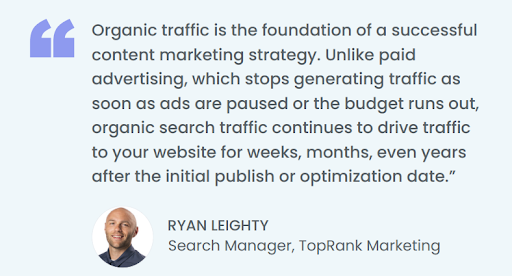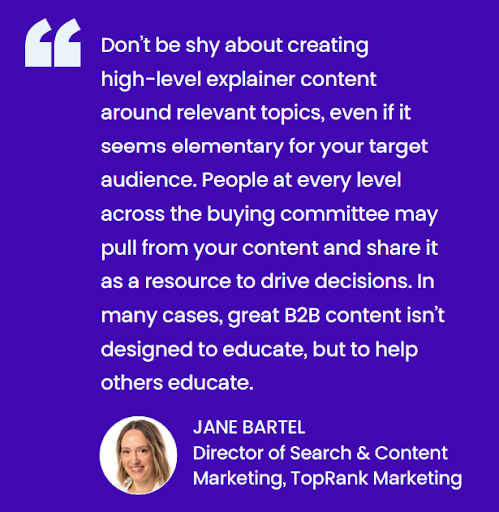At the heart of every B2B purchase decision lies a motivation. The buyer is trying to solve a problem, or improve a process, or gain an edge over their top competitor. Maybe all that and more.
These underlying motivations propel unique journeys that will, hopefully, lead to your brand and solution. But you don’t want to leave it to chance, and that’s why marketing exists.
B2B marketers have grown very adept at using data to find their target audiences across digital channels and media. But too often, they stop short of understanding why prospects and customers are where they are.
An intent-based SEO content strategy centers on buyer motivations, supporting their journeys at various stages with helpful, enlightening, problem-solving content that makes a powerful impression.
“An intent-based SEO content strategy centers on buyer motivations, supporting their journey with problem-solving content that makes a powerful impression.” — Nick Nelson @NickNelsonMN Click To Tweet
It’s why we believe intent-qualified organic traffic will be foundational to B2B marketing success going forward, as we explain in our new free guide, Marketing with Intent. Within you will find a process for creating content that excels based on this framework.
Here, you can learn a little bit more about why adopting this philosophy is essential to future growth in B2B.
Search engines are evolving around user intent
The first thing to understand about search engines like Google is that they are very smart, and getting smarter. You’re not going to game them with keyword stuffing, or empty long-form content, or AI-generated muck. The best way to reach the top of the rankings – and earn the valuable organic traffic that entails – is to create helpful, useful, high-quality content that perfectly matches the intent of the search query.
“Many of us have experienced the frustration of visiting a web page that seems like it has what we’re looking for, but doesn’t live up to our expectations,” acknowledged Danny Sullivan, Google’s public liaison for search, in a 2022 post. “The content might not have the insights you want, or it may not even seem like it was created for, or even by, a person. We work hard to make sure the pages we show on Search are as helpful and relevant as possible.”
Indeed, Google’s big algorithm update late last summer was known as the “helpful content update,” making no secret of the qualities their engine is looking for in prioritized results.
“Google’s big algorithm update in summer of 2022 was known as the ‘helpful content update,’ making no secret of the qualities their engine is looking for in prioritized results.” — Nick Nelson @NickNelsonMN Click To Tweet
Not all organic traffic is equal
Organic search traffic is the lifeblood of a sustainable and efficient B2B content marketing strategy. A report from BrightEdge found that 53{1652eb1ffa4184925f6a63a9c04ea6b421acb7a78117241e7d4325cdca8339fa} of traffic to business websites is accounted for by organic search, making it “the dominant source of trackable web traffic and the largest digital channel.”

With that said, organic traffic is not universally all that valuable. To make a business impact, it needs to be qualified for relevance to your brand, and the simplest method is by orchestrating your SEO strategy around intent.
This way, marketers can ensure that each piece of content they’re creating serves a distinct audience-focused purpose and will generally attract a specific type of individual: folks who are interested in your industry or specialization, educating themselves on key topics and concepts, or keeping up on the news and trends.
Sometimes search intent will drive a person directly toward product evaluation and making a purchase. Obviously those opportunities are extremely valuable, which is why lower-funnel and demand-based content are key components of any B2B SEO strategy, but it’s critical to keep in mind that at any time, a vast majority of your potential buyer audience is not in-market.
That doesn’t mean they aren’t carrying out their job duties everyday, solving problems and answering questions that relate to their role and your solution category. An always-on strategy that accounts for the entire spectrum of buyer needs and motivations ensures you’re providing full coverage and casting a wide net that still filters for relevance.

Example of an intent-driven content experience that delights
Let’s say Joan is a senior financial decision-maker at a major brand, and you’re marketing a tech product geared toward automating financial processes. Joan’s great with numbers but struggles with managing her organization’s expansive and inconsistent digital data. She’s a good fit for what you sell, although she’s not currently aware it exists and not actively seeking it out as a solution.
You create a page all about financial data management and analysis, with content that comprehensively answers the common industry-specific questions your research surfaced around this topic: how to do it, the best tools for the task, and links to resources.
Because your team took the time to strategically plan around user intent, and created stellar content to match that intent, you reached the top end of the search engine results page (SERP) for several related queries. Joan finds your page, loves it, and shares it with her team.
Why was this experience so valuable for your company?
- You were able to qualify Joan as relevant to your brand without requiring any personally identifying information or tracking data – tools that are going extinct in the age of cookie deprecation. The same dynamic is at play for almost anyone who visits this page via organic search: their mere interest in the topic, and their intent in seeking out the information, makes them relevant to your brand in some way.
- Joan clicking on your result near the top of the SERP is a win, not only because it brought her to your content but also because she is smart enough to know what a high-ranking result means: that other searchers have found the content helpful, and that Google deems its source credible and trustworthy.
- When Joan clicks through to the content, she finds out why these things are true. Your company knows what it’s talking about in this area, and there’s plenty more on your website to explore. She clicks around. She shares content to her team. Your brand has made a salient impression in her mind.
That’s a content experience money can’t buy. Lucky, you didn’t need to – the click was free! Investing up-front in strategic and focused SEO content sets the stage for these kinds of budget-efficient, needle-moving engagements to take place in perpetuity.
Grab your guide to intent-based B2B search strategy
The effectiveness of this approach is no simple hypothesis: At TopRank Marketing, we’ve been watching it pay dividends for big-name B2B brands we partner with each day. The premise is fairly straightforward (and nothing revolutionary) but there are certain key things that you’ve got to get right, and most don’t.
By downloading our guide, Marketing with Intent: The Future of SEO and Qualified B2B Traffic, you can unlock tips from our experts and a framework for developing content that ranks for the right keywords.
By reaching out to us, you can get started on putting this model into motion with the help of a proven agency partner.
